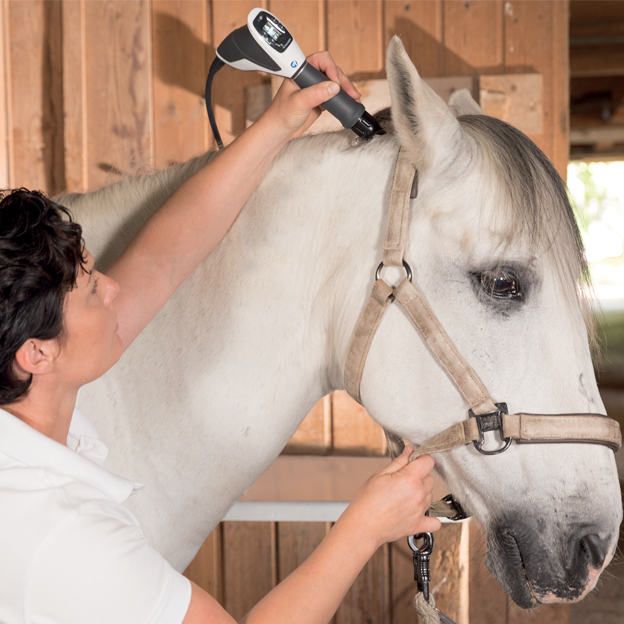Why Equine Therapy is Becoming a Preferred Choice for Emotional Health
Why Equine Therapy is Becoming a Preferred Choice for Emotional Health
Blog Article
How Laser Therapy in Equine Therapy Is Changing Vet Look After Equines
Laser therapy has arised as a transformative approach in equine veterinary treatment, supplying a non-invasive option that speeds up healing and boosts total health and wellness. Leveraging accurate light wavelengths, this advanced therapy stimulates mobile regrowth, decreases swelling, and alleviates pain. Its efficiency prolongs from musculoskeletal injuries to persistent conditions like osteoarthritis, significantly boosting movement and life quality for equines. The transportability and flexibility of laser treatment gadgets further emphasize their growing necessity amongst veterinarians. As we explore the intricate auto mechanics and real-world successes, the profound effect on equine clinical techniques becomes significantly apparent.
Recognizing Laser Therapy

The modern technology behind laser treatment is based in the principle of photochemistry, where photons are taken in by chromophores within cells, causing boosted ATP manufacturing and inflection of reactive oxygen species (Equine Therapy). This, in turn, promotes cellular expansion, lowers inflammation, and speeds up healing. Veterinary professionals use various types of lasers, including low-level lasers (LLLT) and high-power Class IV lasers, depending upon the particular restorative goals and the nature of the equine condition being treated
Different laser wavelengths and power setups are meticulously picked to target numerous cells midsts and accomplish preferred medical results. Safety protocols are paramount, as improper usage can lead to thermal damage or suboptimal therapeutic results. Hence, a thorough understanding of laser treatment's devices and applications is critical for its reliable application in equine veterinary practice.
Advantages for Horse Health
The myriad benefits of laser treatment for equine health include boosted healing, pain reduction, and improved wheelchair. This sophisticated therapy modality leverages details wavelengths of light to permeate cells, stimulating mobile feature and promoting quick tissue repair service. The non-invasive nature of laser therapy makes sure marginal tension and pain for the equine, helping with a smoother recuperation process.
Improved recovery is one of the primary benefits, as laser treatment accelerates mobile regrowth and collagen synthesis. This leads to quicker recuperation times from injuries and operations. Pain decrease is attained through the anti-inflammatory effects of laser therapy, which lowers swelling and reduces the production of pain-inducing chemicals. Because of this, steeds experience significant relief from persistent and intense pain conditions.
By lowering swelling and discomfort, and improving tissue repair work, laser therapy aids in recovering joint feature and muscle mass versatility. Therefore, laser therapy stands as a transformative tool in contemporary horse vet treatment.
Usual Conditions Dealt With
Laser treatment has actually become a flexible therapy alternative for a range of typical equine problems. Amongst these, bone and joint injuries are particularly amenable to laser treatment. Equine Therapy. Soft tissue injuries, such as tendonitis and ligament pressures, gain from the anti-inflammatory and analgesic effects of laser therapies, which speed up healing and lower discomfort. Additionally, laser treatment works for conditions like osteo arthritis, where it assists reduce joint swelling and promote cells fixing.
Wound monitoring is one more location where laser therapy has actually shown considerable promise. Chronic injuries or slow-healing abscess can be especially challenging in steeds, but laser therapy boosts mobile regrowth and improves blood circulation, hence speeding up the recovery procedure. In addition, laser treatments have been efficiently utilized in managing unguis conditions such as laminitis and abscesses, alleviating discomfort and promoting quicker recuperation.

Technology Behind Laser Treatment
Beyond the myriad conditions treatable with laser therapy, the modern technology itself values better evaluation. At the heart of laser treatment is using particular wavelengths of light to permeate tissues and elicit biological actions. These wavelengths, commonly varying from 600 to 1000 nanometers, are precisely taken in by chromophores in the skin, muscle mass, and various other tissues, initiating a cascade of mobile occasions.
Laser devices used in vet medicine website link commonly use low-level laser therapy (LLLT) or chilly laser treatment. Unlike high-powered medical lasers, these tools operate at lower power levels, optimizing healing advantages while decreasing thermal damage. The power from the laser light promotes adenosine triphosphate (ATP) production, boosts mobile metabolism, and accelerates cells repair processes.

Success Stories and Study

Showcasing the tangible benefits of laser treatment, countless success tales and case studies illuminate its transformative effect on equine health and wellness. One such situation includes a pedigreed racehorse suffering from chronic tendonitis. Typical therapies produced marginal renovation, yet after incorporating laser treatment right into the program, the equine displayed considerable reductions in inflammation and discomfort within weeks, inevitably going back to affordable racing.
One more compelling example includes a dressage steed get more identified with serious neck and back pain, limiting its performance. A vet group utilized low-level laser treatment (LLLT) to target the irritated areas, resulting in marked renovation in adaptability and a notable decrease in discomfort. Over several sessions, the steed restored its peak type, showcasing the efficiency of laser treatment in resolving musculoskeletal problems.
Furthermore, a research conducted at a leading equine facility checked out 50 equines with various soft cells injuries treated with laser treatment. The results stood out: 85% of the horses showed sped up healing times and boosted wheelchair. These cases emphasize the convenience and efficiency of laser therapy in equine medication, providing a non-invasive, scientifically-backed their explanation method to enhancing recuperation and performance in horses.
Verdict
Laser therapy is revolutionizing equine vet treatment by offering a non-invasive therapy that speeds up healing, lowers inflammation, and reduces discomfort. With its efficiency in treating a series of problems, from musculoskeletal injuries to chronic disorders like osteo arthritis, this technology significantly enhances equine wellness and movement. The transportability and versatility of laser therapy further emphasize its transformative effect on vet methods, solidifying its role as a vital tool in modern-day equine health care.
Report this page